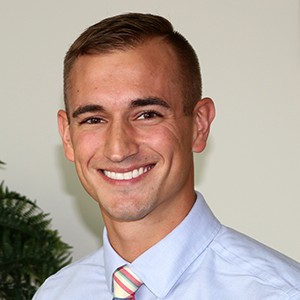The Special Care Clinic at Children’s Hospital Colorado is the largest special needs clinic in the U.S. They serve more than 6,000 individual patients with complex medical conditions and special health care needs and their families.
“About a third of our patients in the clinic are on 10 or more medications. The medication lists are complex and that creates a lot of opportunity for things to go wrong, like drug interactions and side effects,” says Luke Orth, PharmD, BCPPS, assistant professor of clinical pharmacy at the Skaggs School of Pharmacy & Pharmaceutical Sciences. “As a pediatric pharmacist, I'm always thinking about how we can limit those problems.”
Since 2019, Orth and Jamie Feinstein, MD, MPH, professor of pediatrics and an investigator with ACCORDS, have collaborated on several projects to better understand their work in the Special Care Clinic. They are focused on polypharmacy, which is the simultaneous use of multiple medications to treat one or more conditions.
In two recent publications, Feinstein and Orth examine the annual medication cost for children with chronic medical conditions and the associated challenges of managing pediatric polypharmacy.
Through their research they hope to improve children’s safety, the effectiveness of care, and reduce unnecessary costs.
Special considerations for children
Feinstein’s portfolio of medication safety research has demonstrated that polypharmacy risks are greatest among children with special health care needs and medical complexity.
Some of the issues presented in pediatric polypharmacy, like overlapping side effects and duplicative therapies, are similar to those described in adults, particularly geriatric populations.
Feinstein and Orth partnered with Sunny Linnebur, PharmD, professor of clinical pharmacy and a geriatric pharmacist at the UCHealth Seniors Clinic, to better understand the research available regarding polypharmacy in geriatric patients and how they might adapt it for their younger population.
“Managing children with multiple medications early in life—unlike in adult or geriatric patients—means many will experience polypharmacy for decades,” Feinstein explains. “That long trajectory makes it even more critical to intervene early and thoughtfully.”
Children as young as a few months may begin accumulating medications that remain for years and decades. The care teams need to evaluate the continuing therapies that are needed and identify strategies for cautiously removing those that aren’t to ensure children are safe over a much longer time span.
Drug utilization reviews performed routinely by state agencies are one essential safeguard that promotes safe and appropriate use, but the nuanced health care needs of children with medical complexity may present unique challenges which extend beyond the scope of these high-level reviews alone.
“We’re not just navigating the clinical complexity of different developmental stages,” Feinstein adds. “We also have to ensure families can safely manage care at home by tailoring our approach to each family’s health literacy, preferred language, and learning style.”
Addressing medication regimen complexity
Taking multiple medications is challenging on its own, but for patients at the Special Care Clinic, there are often additional layers of complexity.
There are more calculations involved in dosing a medication for a two-year-old compared to a 17-year-old, children often see multiple sub-specialists focused on their own specialty areas, and some children are being administered a median of 30 doses of medication a day.
“Many of our children need to receive medications and nutrition through enteral feeding tubes,” Orth says. “To get medications into a form that's appropriate for administration through a feeding tube, we often have to manipulate them by crushing tablets or opening capsules to mix into a liquid.”
These types of considerations increase the complexity of medication regimens for clinicians and caregivers.
To help understand perceptions of medication use in the home, the team is conducting qualitative interviews with caregivers.
“We want to address not only the things that we as providers think are the most impactful, but also what the caregivers think would be the most impactful for future research targets,” Orth says. “A big part of that involves the process of using medications.”
“Simplifying medication regimens isn’t just a matter of convenience,” Feinstein says. “It’s about helping caregivers feel confident and equipped to manage complex care day in and day out, which is essential to ensuring both safety and effectiveness.”
Adapting medication therapy management
Interviews with prescribers and clinicians, including Orth, revealed that despite integrated systems like electronic health records, there still is not a streamlined way to coordinate all the necessary information to safely care for these children.
The intervention being tested by the team focuses on the centralization of the pharmacist, who can support these clinical spaces, provide a comprehensive assessment, and make recommendations for the entire care team. This ensures consideration for the child globally versus one organ system at a time.
One option they are exploring is whether adult medication therapy management (MTM) can be effective in a high-risk pediatric population.
“Medication therapy management, and its partner term, comprehensive medication management, have been established for close to 20 years as an impactful way to reduce cost, improve adherence, and potentially impact effectiveness and safety of medication regimens in adult populations,” Orth says.
These programs are often provided at no cost to Medicare beneficiaries who exceed an annual prescription cost threshold, but its effectiveness has never been explored in pediatric populations.
Using data from the 2022 Colorado All Payer Claims Database, their study found that about 5% of the Colorado children met the adult threshold to qualify for medication therapy management.
“We know that is important to identify the groups of children who would benefit most from our pharmacist intervention, given the need for stewardship of our available resources. We found that higher levels of polypharmacy and increased level of medical complexity contributed to a greater likelihood that these patients would meet the adult cost thresholds, which validates our current research methods and provides clinicians around the country with a more focused target audience for medication therapy management to occur among the pediatric subgroup,” Orth says.
Role of pediatric pharmacists
Because of limited appointment times, families may not always get to talk extensively about the medications being prescribed during their visits.
“I get to have focused conversations on that aspect. It gives the families more confidence in recognizing how the medications are helping their children and whether problems related to medications are occurring,” Orth says.
Their research is exploring how to make it economically feasible to support a pediatrics-trained pharmacist for a small population of children.
“Pharmacist services don’t have to be limited to the clinic setting,” Feinstein explains. “With virtual access, a single pharmacist could deliver medication therapy management across multiple sites, which makes this kind of support feasible even for practices that serve only a small number of children with polypharmacy.”
Feinstein and Orth are hopeful that their research will allow them to provide this added service for all children who need it. Their work has been well received by families who appreciate the opportunity to talk about medication outside of a usual clinic visit.
“My personal goal is to make it so that every pediatric clinic has access to their own dedicated pharmacist, because it's an important role in ensuring safety, medication effectiveness, and optimal outcomes in the health care of these children,” Orth says.





